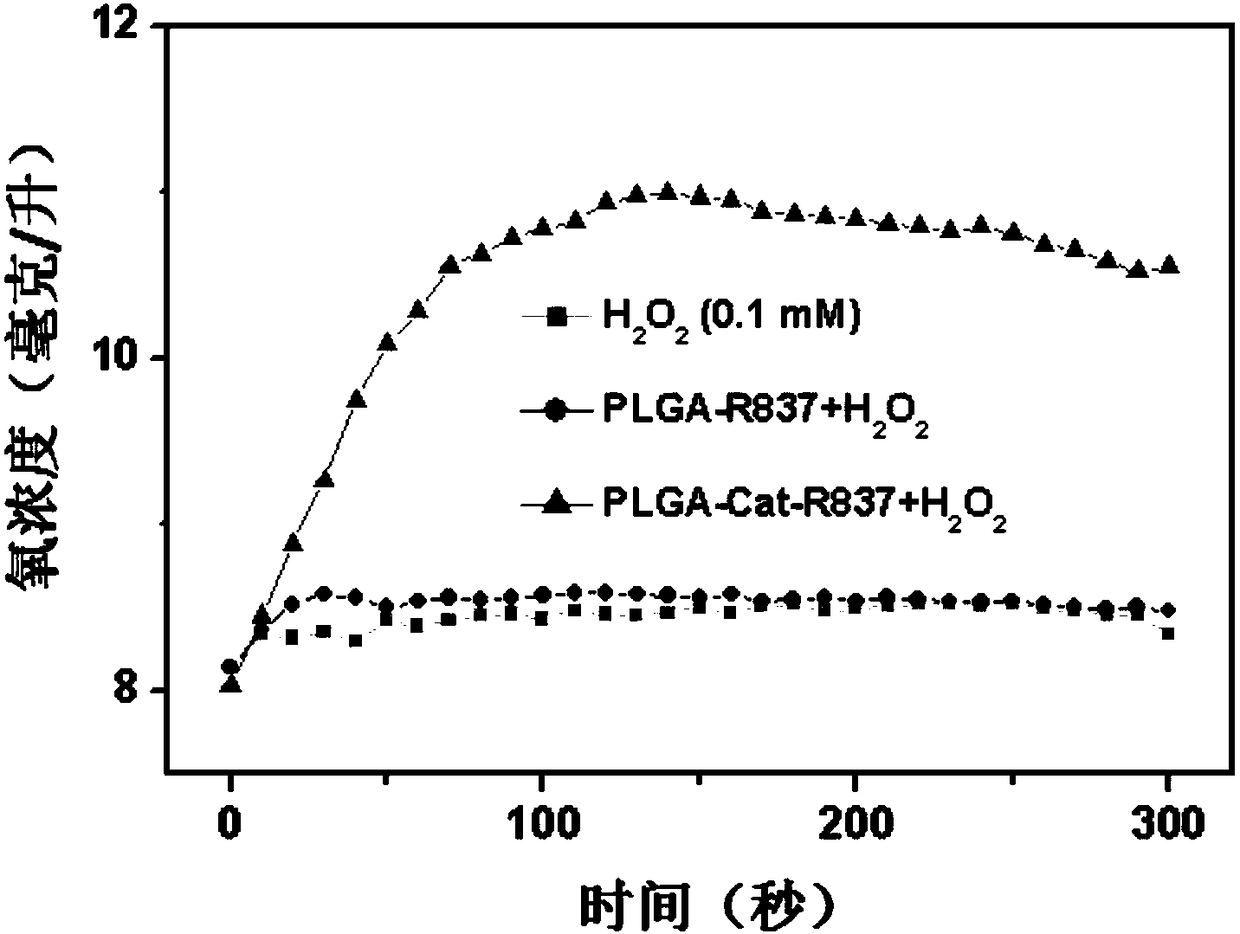Polymer nano adjuvant as well as preparation method and application thereof
A polymer and nanotechnology, applied in the fields of biochemical equipment and methods, drug combination, drug delivery, etc., can solve the problems of hypoxia, cancer treatment drug resistance and radiotherapy failure, and achieve inhibition of tumor metastasis, inhibition of primary tumor formation, good water solubility and biocompatibility
- Summary
- Abstract
- Description
- Claims
- Application Information
AI Technical Summary
Problems solved by technology
Method used
Image
Examples
Embodiment 1
[0045] Example 1: Preparation of poly(lactic acid-glycolic acid)-imidazoquinoline@catalase (PLGA-R837@Cat) nano adjuvant:
[0046] Encapsulation of catalase (CAT) and immunostimulant imidazoquinoline (R837) into block polymer poly(lactic acid-glycolic acid) (PLGA) by water / oil / water (W / O / W) , forming nanoparticles. Specifically include the following steps:
[0047] Dissolve poly(lactic acid-glycolic acid) (PLGA) in volatile organic solvents such as dichloromethane, and dissolve catalase (CAT) in surfactants such as 1% polyvinyl acetate (PVA). or mixed and ultrasonically obtained the first emulsified solution under ice-bath conditions; then the imidazoquinoline (R837) solution dissolved in dimethyl sulfoxide (DMSO) was added dropwise to the first emulsified solution; and further under ultrasonic conditions Adding 1% polyvinyl acetate (PVA) solution to finally obtain the water / oil / water poly(lactic acid-glycolic acid) nano adjuvant (PLGA-R837@Cat). Then, it is characterized (tr...
Embodiment 2
[0049] Example 2: Preparation of poly(lactic acid-glycolic acid)-monophosphoryl lipid A@catalase (PLGA-A(MPLA)@Cat) nano adjuvant:
[0050] The catalase (CAT) and the immunostimulant monophosphoryl lipid A (A (MPLA)) are wrapped into the block polymer poly(lactic acid-glycolic acid) (PLGA) by the W / O / W method, form nanoparticles. Specifically include the following steps:
[0051] Dissolve poly(lactic acid-glycolic acid) (PLGA) in volatile organic solvents such as dichloromethane, and dissolve catalase (CAT) in surfactants such as 1% polyvinyl acetate (PVA). or were mixed and ultrasonically obtained in an ice bath to obtain the first emulsified solution; then a monophosphoryl lipid A (A(MPLA)) solution dissolved in dimethyl sulfoxide (DMSO) was added dropwise to the first emulsified solution; And further added into a 5% polyvinyl acetate (PVA) solution under ultrasonic conditions to finally obtain a water / oil / water poly(lactic acid-glycolic acid) nano adjuvant (PLGA-R848@Cat)...
Embodiment 3
[0052] Example 3: Determination of Poly(lactic acid-glycolic acid)-immunostimulant @ catalase oxygen production capacity
[0053] Poly(lactic-glycolic acid)-immunostimulant @ catalase (PCR) and poly(lactic-glycolic acid)-immunostimulant (PC) were dissolved in 100 micromolar hydrogen peroxide solution using an oxygen electrode Oxygen produced is detected.
[0054] attached image 3 It is the ability of PCR to generate oxygen in hydrogen peroxide solution. It can be seen that a large amount of oxygen can be generated in the hydrogen peroxide solution added to PCR. This shows that catalase is still active. In contrast, PC without catalase cannot catalyze the decomposition of hydrogen peroxide, and the hydrogen peroxide solution itself is relatively stable and difficult to decompose.
PUM
| Property | Measurement | Unit |
|---|---|---|
| particle diameter | aaaaa | aaaaa |
| molecular weight | aaaaa | aaaaa |
Abstract
Description
Claims
Application Information
 Login to View More
Login to View More - R&D
- Intellectual Property
- Life Sciences
- Materials
- Tech Scout
- Unparalleled Data Quality
- Higher Quality Content
- 60% Fewer Hallucinations
Browse by: Latest US Patents, China's latest patents, Technical Efficacy Thesaurus, Application Domain, Technology Topic, Popular Technical Reports.
© 2025 PatSnap. All rights reserved.Legal|Privacy policy|Modern Slavery Act Transparency Statement|Sitemap|About US| Contact US: help@patsnap.com



